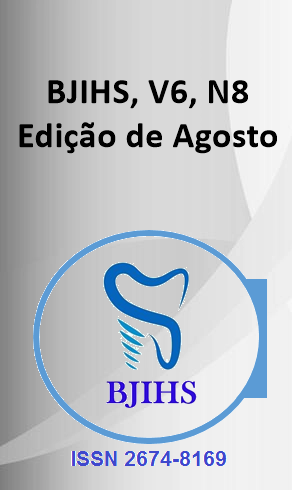Abstract
Introduction: Leptospirosis is an infectious disease caused by bacteria of the genus *Leptospira*, with a higher incidence in tropical and subtropical areas. Transmission occurs mainly through contact with urine from infected rodents, affecting populations in poor sanitation conditions. In Brazil, it is a notifiable disease, with a higher prevalence in the South and Southeast regions, especially among workers exposed to unhealthy environments. Leptospirosis is considered a neglected disease, with a significant impact on public health and high hospital costs. Objective: The present study aims to analyze the epidemiological profile of the disease in Brazil between 2012 and 2022 according to age group and Brazilian region. Methods: This is a quantitative observational cross-sectional study carried out using data from DATASUS. The variables analyzed were: age group, the 5 regions of the Brazilian territory, and education. The analysis stage allowed a clear and understandable view of the data collected, helping to draw accurate and informed conclusions about the epidemiological framework studied. This does not directly involve human beings. Results: Brazil has recorded approximately 35,000 cases of leptospirosis since 2012, with the highest incidence in 2014 and a significant drop in 2020-2021 probably due to the COVID-19 pandemic. The most affected age group was 29-30 years old, accounting for 39.38% of cases. The territorial analysis showed that the South region of Brazil led in leptospirosis notifications (31.5%), followed by the Southeast (31.2%). In terms of education, most cases occurred among people with incomplete 5-8 grades of elementary school (24.43%). Conclusions: The analysis from 2012 to 2022 reveals that the high prevalence of leptospirosis in Brazil is linked to climatic and socioeconomic factors, especially in low-income areas and among individuals with less education. The disease mainly affects young adults, highlighting the need for health policies and preventive measures, such as the use of protective equipment.
References
BOEY, K.; SHIOKAWA, K.; RAJEEV, S. Leptospira infection in rats: A literature review of global prevalence and distribution. PLOS Neglected Tropical Diseases, v. 13, n. 8, p.1 - 24, 9 ago. 2019. Disponível em: https://journals.plos.org/plosntds/article/authors?id=10.1371/journal.pntd.0007499
Brasil. Ministério da Saúde. Secretaria de Vigilância em Saúde. Coordenação-Geral de Desenvolvimento da Epidemiologia em Serviços. Guia de Vigilância em Saúde: volume único [recurso eletrônico] / Ministério da Saúde, Secretaria de Vigilância em Saúde, Coordenação Geral de Desenvolvimento da Epidemiologia em Serviços. – 3ª. ed. – Brasília: Ministério da Saúde, 2019. 740 p. Disponível em: https://bvsms.saude.gov.br/bvs/publicacoes/guia_vigilancia_saude_3ed.pdf
BRASIL. Ministério da Saúde. Secretaria de Vigilância em Saúde. Sistema Nacional de Agravos de Notificação (SINAN). Brasília, DF: MS, 2021. Disponível em: http://www.saude.gov.br/sinan_net.
BRASIL. Ministério da Saúde. Secretaria de Vigilância em Saúde e Ambiente. Departamento de Ações Estratégicas de Epidemiologia e Vigilância em Saúde e Ambiente. Guia de vigilância em saúde: volume 3 [recurso eletrônico] / Ministério da Saúde, Secretaria de Vigilância em Saúde e Ambiente, Departamento de Ações Estratégicas de Epidemiologia e Vigilância em Saúde e Ambiente. – 6. ed. rev. – Brasília: Ministério da Saúde, 2024. 3 v.: il. Modo de acesso: World Wide Web: https://bvsms.saude.gov.br/bvs/publicacoes/guia_vigilancia_saude_6edrev_v3.pdf ISBN 978-65-5993-503-1
Costa F, Hagan JE, Calcagno J, Kane M, Torgerson P, Martinez-Silveira MS, et al. Global Morbidity and Mortality of Leptospirosis: A Systematic Review. PLoS Neglected Tropical Diseases [Internet]. 2015 Sep 17;9(9). Disponível em: https://pubmed.ncbi.nlm.nih.gov/26379143/
DAY, N. UpToDate. Leptospirosis: Epidemiology, microbiology, clinical manifestations, and diagnosis. Disponível em: <https://www.uptodate.com/contents/leptospirosis-epidemiology-microbiology-clinical-manifestations-and-diagnosis?search=leptospira&source=search_result&selectedTitle=1%7E87&usage_type=default&display_rank=1#H15>. Acesso em: 27 jun. 2024.
DIZ, F. A.; CONCEIÇÃO, G. M. DE S. Human leptospirosis in the municipality of São Paulo,
SP, Brazil: distribution and trend according to sociodemographic factors, 2007–2016. Revista Brasileira de Epidemiologia, v. 24, 2021. Disponível em : https://www.scielo.br/j/rbepid/a/vT5jQ9SCm4DywYGTLHHqCgq/?lang=en
MAGNAVITA, V.; CONDE, I. Leptospirose: um estudo epidemiológico dos casos notificados no Brasil entre os anos de 2015 e 2019. UNIVERSIDADE FEDERAL DO ACRE FACULDADE DE MEDICINA: [sn].
MARTINS, M. H. M.; SPINK, M. J. P. Human leptospirosis as a doubly neglected disease in Brazil. Ciência & Saúde Coletiva v.25, n.3, p. 919 - 928 2020. Disponível em: https://www.scielo.br/j/csc/a/H7WKT5SqhsmdHBQmShHT7RK/?format=pdf&lang=pt
OLIVEIRA, P. P. V. Fatores de risco para leptospirose como doença ocupacional em surto no interior do Ceará: um estudo de caso controle. 2012. 64p. Dissertação (Mestrado Profissional em Epidemiologia em Saúde Pública) – Fundação Oswaldo Cruz, Rio de Janeiro.
OLIVEIRA, V.; SANTOS, A. F. DOS; CAMPOS, H. Leptospirose: um estudo epidemiológico dos casos notificados no Brasil entre os anos de 2015 e 2019/Leptospirosis: an epidemiological study of notified cases in Brazil between the years 2015 and 2019. Brazilian Journal of HealthReview,v. 5, n.2, p.5964 – 5979, 5 abr.2022. Disponível em: https://doi.org/10.34119/bjhrv5n2-173
Pavli A, Maltezou HC. Travel‐Acquired Leptospirosis. Journal of Travel Medicine. 2008 Nov 1;15(6):447–53. Disponível em: https://pubmed.ncbi.nlm.nih.gov/19090801/
SOO, Z. M. P.; KHAN, N. A.; SIDDIQUI, R.
Leptospirosis: Increasing importance in developing countries. Acta Tropica v.201. Disponível em: https://pubmed.ncbi.nlm.nih.gov/31542372/
World Health Organization. Human leptospirosis: guidance for diagnosis, surveillance and control. 2013. Disponível em: https://www.who.int/publications/i/item/human-leptospirosis-guidance-for-diagnosis-surveillance-and-control

This work is licensed under a Creative Commons Attribution 4.0 International License.
Copyright (c) 2024 Ana Clara Carvalho Zanette, Karina Korkmaz Guisard , Maria Eduarda Rabelo de Souza Lima , Catherine Yurie Minasse, Sophia Tiosso Rodrigues , Rozileide Martins Simões Candeia

